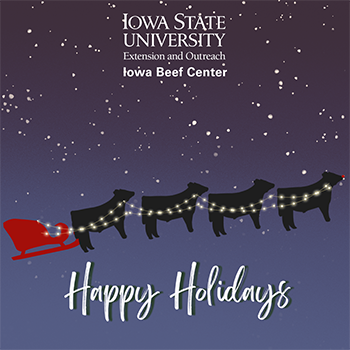Holiday dinner for the pasture
12/21/23

AMES, Iowa – Aside from visiting loved ones, my favorite thing about the holidays is the food. Particularly the big sit-down meal shared with a full table. So, my question today: what would that holiday spread look like for a blade of grass in the pasture? Simply put, what can we, as grass growers, provide to satisfy our pastures in the growing season?
Preparation: Groceries and cooking for me, soil test and expert advice for my pasture
A good holiday meal is not a one-day endeavor and should not rely solely on one person. Preparation is key. The same is true in order to feed our pastures a good “meal.” Starting by taking a soil test to identify what nutrients are adequate or lacking is like taking inventory in your pantry and making a grocery list. To plan how much you need, you rely on others to tell you how many to prepare food for. For the pasture, working with agronomists, extension specialists, or other experts can help you correctly identify how much fertilizer to buy, and what it should contain to avoid over or underspending.
Table Setting: Good dishes for me, fence and water infrastructure for my pasture
A memorable holiday meal has a beautifully set table. For our pastures, at minimum we need an exterior fence (plate) and a water source (silverware.) We can greatly improve our table by going beyond the minimum with centerpieces, napkins, etc. In pastures, adding paddocks to rotate and additional water sources play a huge role in grazing utilization, distribution, and the growth patterns of our grasses.
Now, for the dinner itself
Main dish: Prime rib for me, water for my pasture
I realize irrigating most pasture ground isn’t feasible. We’re at the mercy of Mother Nature, kind of like we’re at the mercy of our wallet when selecting the main dish for our holiday dinner. However, when it comes to what is the most nourishing, growth-promoting dish on the table, it’s the main course. For grass in the pasture, this is, without a doubt, water.
Vegetable: Green beans for me, lime for my pasture
As I’ve grown older, the importance of veggies has become more pronounced … without fiber, I get an upset stomach and the joyful bliss following a tasty meal is short-lived. Lime is a useful product for pastures because of its influence on soil pH. If soil pH is not optimal, plants don’t get good utilization from the other nutrients provided. A high pH will tie up nutrients like iron and manganese while a low pH can tie up sulfur, potassium, and phosphorus. The general rule is a pH around 6 is ideal for cool season grasses, while a slightly higher (less acidic) pH of 6.5 is ideal for clovers and grass/legume pasture mixes.
Sides: Potatoes for me, phosphorus for my pasture
Sides can cause quite a debate in the human world, but I would bet most of us picture a starch heavy side. For us, starches are high energy feed sources. In plants, a major role of phosphorus is in ATP, which is the driving compound for a plant’s energy system. Phosphorus is also in DNA, RNA, and phospholipids, making it a critical nutrient to utilize when trying to optimize and improve pasture growth.
Drink: Wine for me, potassium for my pasture
For a prime rib holiday dinner, wine is often the beverage of choice. It pairs nicely with the rest of the meal and helps wash things down. Red wine in particular is touted to have an effect that can increase our metabolism. In plants, potassium plays a major role in metabolism, and is necessary for photosynthesis and protein synthesis (i.e., growth.) In addition, potassium has a role in a plant’s drought tolerance and winter hardiness, which for me gives an added comparison with the alcohol content of the wine helping me relax during some dinner conversations.
Dessert: Pie for me, nitrogen for my pasture
I have a sweet tooth, and that dessert is immediately satisfying. Plus, the more I eat the quicker growth I experience (even if it’s not exactly the type of growth I want.) In pasture, nitrogen fertilization is best known for its ability to induce a positive growth response. How well it responds depends on a variety of factors.
Seasonings: Midwest made blends for me, micro and macro nutrients for my pasture
There is a wide variety of seasonings available, just like there is a wide variety of micro and macro nutrient and additive options to apply to a pasture. The right choice is strongly influenced by the unique palettes of people sitting at the table. Each pasture is unique. Geography can tell us a lot about what might be a good fit. Different regions have different nutrient deficiencies in their soils. Knowing the region, utilizing soil test reports, and customizing a fertilization plan for each pasture is kind of like selecting the seasonings that make the meal as a whole just right.
We could go on with this list. The more options at the table, the better the meal becomes. The complexity of growth in a pasture and symbiotic relationships between different plant species growing make feeding and caring for perennial pastures so unique, challenging, and fun.
Happy holidays! I hope your table is full of family, friends, and food!
Originally published in the November issue of the Iowa Forage and Grassland Council's "The Forager."
-30-
The Iowa Beef Center at Iowa State University was established in 1996 with the goal of supporting the growth and vitality of the state’s beef cattle industry. It comprises faculty and staff from Iowa State University Extension and Outreach, College of Agriculture and Life Sciences and College of Veterinary Medicine, and works to develop and deliver the latest research-based information regarding the beef cattle industry. For more information about IBC, visit www.iowabeefcenter.org.
Contact:
Beth Reynolds, Iowa Beef Center program specialist, 515-294-9881, bethr@iastate.edu
